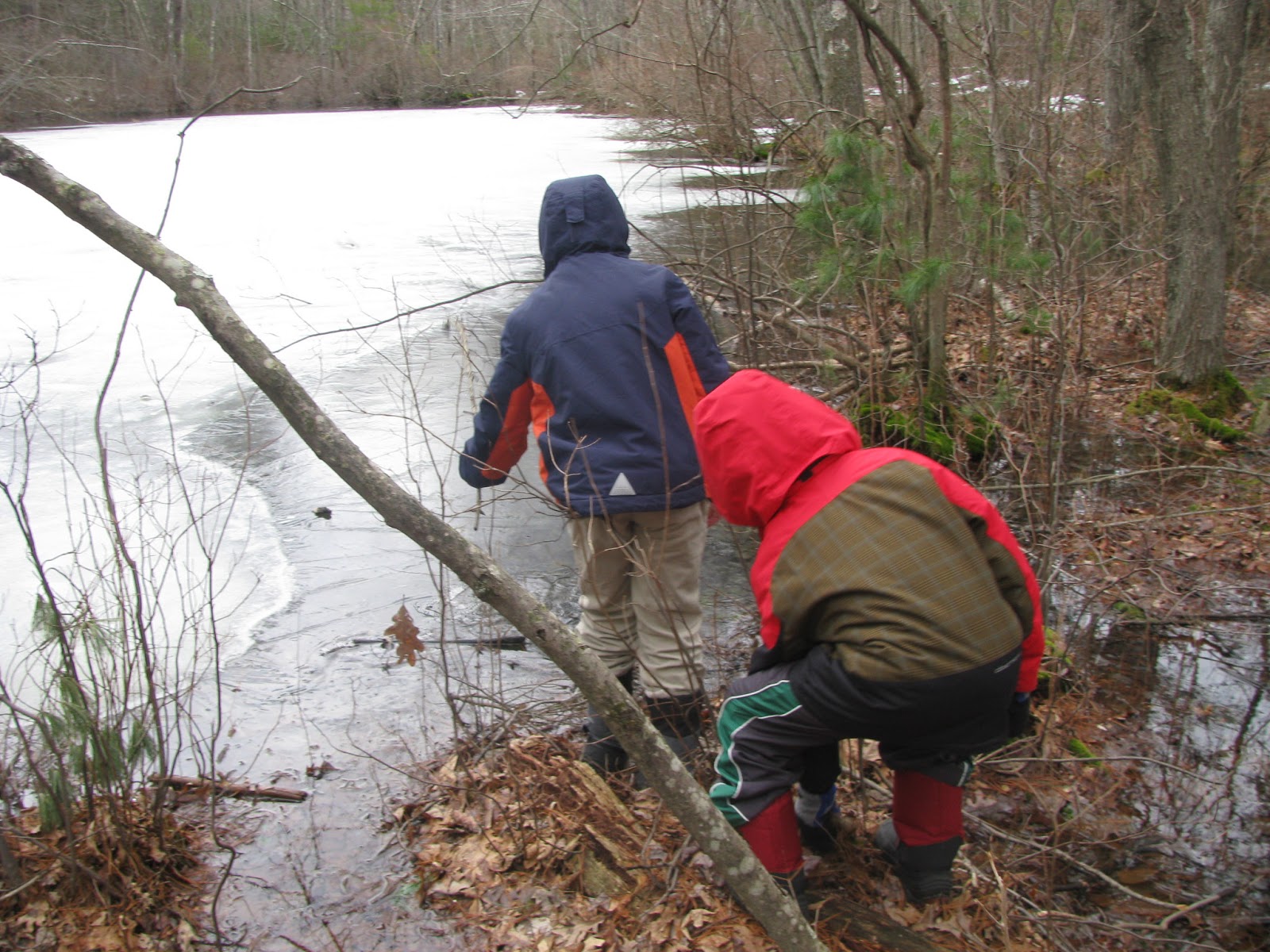It's the middle of March now, so we took a field trip to Needham's Town Forest to look for vernal pools. Very soon, these pools will be visited by breeding amphibians - frogs, toads, salamanders. A "vernal pool" is a small pond that forms in woods in the spring from melting snow and spring rains. These are good places for amphibians to breed because they dry up or shrink a lot in summer, so fish usually cannot live in them, and fish love to eat amphibian eggs! The eggs hatch and then the tadpoles grow and develop into their adult forms before the pool dries up.
The earliest arrivals to vernal pools around here are yellow-spotted salamanders and wood frogs. They are expected between the middle of March and the end of the month. The first warm, rainy night in this breeding season is a good time to look for salamanders and wood frogs heading to the pools. They lay jelly-like eggs that stick together in egg masses in the water.. During breeding season, you can often locate a vernal pool by listening for what sounds like ducks quacking, but you don't see any ducks - those are wood frogs calling!
 We drove to the Robinwood Ave. entrance to Town Forest. The first thing we noticed in the forest was a rushing stream near the entrance. We explored along it and crossed it on a log. There was a lot of long, bright green algae growing on the rocks. It streamed out like green hair in the stream's flow. Then we followed a trail toward a small pond where our instructor had found wood frog eggs in past years. On the way there, our instructor pulled out a deer's skeletal leg that she found in this spot 2 days ago and had hidden. It was cool to check it out. We wondered how the deer had died, but didn't find any clues on the leg. The leg might have gotten separated from the rest of the deer's bones by a dog finding it and carrying it away to chew on and play with.
We drove to the Robinwood Ave. entrance to Town Forest. The first thing we noticed in the forest was a rushing stream near the entrance. We explored along it and crossed it on a log. There was a lot of long, bright green algae growing on the rocks. It streamed out like green hair in the stream's flow. Then we followed a trail toward a small pond where our instructor had found wood frog eggs in past years. On the way there, our instructor pulled out a deer's skeletal leg that she found in this spot 2 days ago and had hidden. It was cool to check it out. We wondered how the deer had died, but didn't find any clues on the leg. The leg might have gotten separated from the rest of the deer's bones by a dog finding it and carrying it away to chew on and play with. 

Then we followed the trail to a much smaller vernal pool. We found a large slug in there. It looked like it had drowned. This pool was shallow enough to see to the bottom very well. We also found an "oak apple gall" and learned how a small wasp had laid an egg on an oak leaf. The egg hatched and the tiny larva started eating and the leaf then grew a rounded growth over this irritation. This growth is a gall, and the larva developed in it. When it developed into an adult, it then chewed a hole in the gall to get out.
Next, we followed a trail to an unusual and cool place in this forest. You'll have a ask a Green Ranger about it! The trail went up and down over rocky hills and we crossed a wooden bridge over a stream. We arrived at our destination, and after checking out all of the interesting things there, we had hot chocolate with marshmallows! We followed a stream downhill and explored the wetland that formed below. Skunk cabbage was blooming. It is a very early wetland bloomer with a thin, rod-like flower inside a mottled purplish "hood" (spathe). It has a slightly stinky smell and is very unusual because it can create its own heat (thermogenesis). The smell and, probably the heat as well, attract early pollinators - flies and beetles. (see picture of skunk cabbage below.) We also found a red-backed salamander and a red eft (land-living part of the newt's life cycle) under a log! Then we had to hurry back to get to the Science Center for pick-up time.










No comments:
Post a Comment